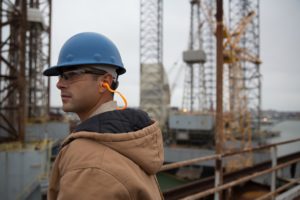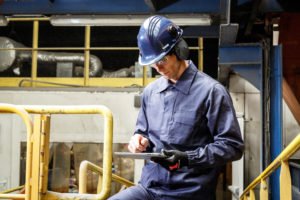Kjersti Rutlin, hearing conservation manager EMEA at Honeywell Industrial Safety, discusses how the latest technology can meet the challenge of noise induced hearing loss.
Noise induced hearing loss (NIHL) is the most commonly reported work-related injury globally. In the UK alone, some 17,000 people suffer deafness, ringing in the ears or other ear conditions caused by excessive noise at work.
The tragedy is that most of these injuries could have been prevented had an effective noise exposure monitoring strategy been in place. In other words, knowing the real noise levels workers are exposed to over time is key to providing them with the best hearing protection.
More attention
Over the last two decades, regulations have helped to ensure that occupational NIHL – an often neglected ‘hidden injury’ – is given more attention.
The Control of Noise at Work Regulations 2005, which translated Directive 2003/10/EC into UK law, mandates that employers provide a worker with hearing protection if their daily or weekly average exposure exceeds 85 decibels.
More recently, the new PPE Regulation (EU) 2016/425, which moves hearing protection from category 2 to category 3 (the highest risk category), has offered further opportunities to raise awareness of hearing conservation at work.
Safeguarding hearing
However, unless we are able to gain a reliable picture of actual noise exposure levels and how these evolve over time, regulations alone may not be enough to safeguard the workforce’s hearing effectively. The problem is that, traditionally, connecting the dots between ‘guessing’ and ‘knowing’ real exposure levels has not been an easy task.
Take, for example, a typical industrial plant environment. Noise exposure levels may vary significantly throughout the day and from one location to another, depending on the type of machinery being operated and the number of people working in a certain section of the factory at a given time.
Technology can certainly play a key role in helping plant and safety managers rise to the challenge, yet, until recently, it has had its limitations. For example, sound level meters can be a useful way of measuring sound pressure levels in a specific location of the plant where noise levels are relatively steady and continuous.
Variations

Oil and gas industries: a potentially dangerous environment for hearing loss
However, these devices don’t account for any variations in these levels. A sound level meter may tell you that the sound pressure in one section of the factory is relatively low, but step a bit closer to a machine and the actual noise level you are exposed to could be significantly higher.
More importantly, a worker’s real exposure to noise may be higher than that of a colleague working in the same location, and using the exact same personal protective equipment (PPE), simply because they are not wearing it correctly or consistently.
Noise dosimeters on the other hand can be worn by the worker and provide a more accurate picture of noise levels across different locations enabling safety managers to then calculate an average of the noise levels workers have been exposed to over time. However these devices don’t provide information on the PPE’s attenuation levels, which is key to knowing the actual noise exposure levels.
SNR value
Traditionally, the most common way of identifying attenuation levels has been the single number rating (SNR) value. Yet, the SNR is population-based and provides a very rough estimate of the potential attenuation that can be achieved from PPE when used correctly.
For example, there can be a significant difference in individual attenuation levels from the same type of earplugs, depending on how well the individual has fitted them. Simply relying on SNR to determine attenuation levels therefore may result in workers not having the protection levels they require.
So what is the best hearing protection and conservation strategy? And how do we know whether it is working or not? The answer to such challenges may now be offered by a more connected approach to hearing conservation.
Data

Assessing noise levels in plant is crucial to ensure protection from hearing loss
By integrating smart, wearable sensors with cutting-edge software and cloud-based services, the latest technology enables both workers and safety managers to measure and monitor noise exposure in real-time. This data can be used to implement proactive safety measures before hearing damage occurs.
For example, some of the latest technologies activate an automatic fit-test during start-up, which tells the worker when they have fitted their hearing protection correctly. They also monitor sound exposure continuously, alerting the user whenever the permissible sound exposure level has been reached. Users can also perform a quick audiometric test to monitor their hearing threshold – and how this evolves over time – and be alerted as soon as a negative trend is detected.
By embedding sensors in PPE to capture data at the point where the individual enters the working environment, the latest connected technology also enables safety and plant managers to track and analyse noise exposure data over time. This allows them to determine exactly how long a worker can stay on task and still be safe or change working patterns accordingly if necessary.
Armed with real-time data and intelligence, plant and safety managers can also check whether workers are wearing the right type of protective equipment and have had the correct training.
Productivity
Besides offering an essential tool to improve occupational health, this new technology can also have a positive impact on plant productivity and efficiency. Exposure to noise can have a negative impact on focus and stress levels, which can be detrimental to productivity.
Knowing that they can count on safety intelligence, workers can focus on their tasks without worrying about being protected. Honeywell’s market feedback also shows that the latest cloud-based technology can deliver 30-40 per cent efficiency gains for safety managers through improved compliance management.
Ultimately, campaigns like the HSE’s new Helping Great Britain Work Well strategy highlight the need to shift the focus for action towards tackling long-term ill-health, not only immediate and visible threats to safety.
With this in mind, it is vital to identify exposure levels before it’s too late – not only to potentially fatal substances such as gas – but also to other dangers such as noise which can cause significant long term damage to health.
A connected safety approach can help determine what actions are required to drive further improvements in safety and, increasingly, health.
Approaches to managing the risks associated Musculoskeletal disorders
In this episode of the Safety & Health Podcast, we hear from Matt Birtles, Principal Ergonomics Consultant at HSE’s Science and Research Centre, about the different approaches to managing the risks associated with Musculoskeletal disorders.
Matt, an ergonomics and human factors expert, shares his thoughts on why MSDs are important, the various prevalent rates across the UK, what you can do within your own organisation and the Risk Management process surrounding MSD’s.




Known, known’s and unknown known’s and what to do about it when expediency is so often the easier decision when the known has an unknown ‘reasonably practicable’ mitigative intervention or perhaps requires some effort to be part of the solution rather than remaining just part of the problem through denial & omission. Computer Vision Syndrome or Screen Fatigue has been one of those expediencies where easier to dismiss as a “TEMPORARY” yet, long-term and debilitating hazard suffered by DSE user operators who have been coping with and tolerating ever since the Cathode Ray Tube became a VDU. However, both the… Read more »